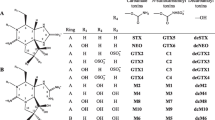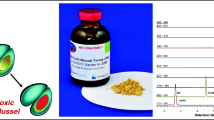Abstract
The effect of γ-irradiation on concentrations of hydrophilic and lipophilic phycotoxins has been investigated by use of HPLC–UV and LC–MS. Pure toxins in organic solvents and toxins in mussel (Mytilus edulis) tissues were irradiated at three different doses. In solution all toxin concentrations were reduced to some extent. Most severe decreases were observed for domoic acid and yessotoxin, for which the smallest dose of irradiation led to almost complete destruction. For pectenotoxin-2 the decrease in concentration was less severe but still continuous with increasing dose. Azaspiracid-1 and okadaic acid were the least affected in solution. In shellfish tissue the decrease in toxin concentrations was much reduced compared with the effect in solution. After irradiation at the highest dose reductions in concentrations were between ca. 5 and 20% for the lipophilic toxins and there was no statistical difference between control and irradiated samples for azaspiracids in tissue. Irradiation of shellfish tissues contaminated with domoic acid led to a more continuous decrease in the amount of the toxin with increasing dose. The effect of irradiation on the viability of microbial activity in shellfish tissues was assessed by using total viable counting techniques. Microbial activity depended on the type of shellfish and on the pretreatment of the shellfish tissues (with or without heat treatment). As far as we are aware this is the first investigation of the effectiveness of irradiation as a technique for stabilising tissue reference materials for determination of phycotoxins. Our results suggest that this technique is not effective for materials containing domoic acid. It does, however, merit further investigation as a stabilisation procedure for preparation of shellfish tissue materials for some lipophilic toxins, in particular azaspiracids.

Chemical structures of the toxins investigated in the study





Similar content being viewed by others
References
NRC-CNRC Institute for Marine Biosciences. NRC CRM-ASP-Mus-c & NRC CRM-DSP-mus-b. Certificates of Analysis
Quilliam MA, Reeves K, MacKinnon S, Craft C, Whyte H, Walter J, Stobo L, Gallacher S (2006) Preparation of reference materials for azaspiracids. In: Deegan B, Butler C, Cusack C, Henshilwood K, Hess P, Keaveney S, McMahon T, O’Cinneide M, Lyons D, Silke J (eds) Molluscan Shellfish Safety. p 111--115, ISBN 1-902895-33-9
Quevauviller P, Maier EA (1999) Interlaboratory studies and certified reference materials for environmental analysis: the BCR approach. Elsevier, Techniques and Instrumentation in Anal Chem vol 22
Clancy V, Willie S (2004) Preparation and certification of a reference material for the determination of nutrients in seawater. Anal Bioanal Chem 378(5):1239–1242
Rehmann NP, Kilcoyne J, Hess P (2004) Isolation and purification of azaspiracids from naturally contaminated mussels. In: Deegan B, Butler C, Cusack C, Henshilwood K, Hess P, Keaveney S, McMahon T, O’Cinneide M, Silke J (eds) Proceedings of the 5th International Conference of Molluscan Shellfish Safety, 14–18 June 2004, Galway, Ireland. Galway, Ireland: Marine Institute, in press
McCarron P (2003) Report on preparation of tissue reference materials for azaspiracids and dinophysistoxins. Marine Institute, unpublished information, ASTOX: 1st quarterly report
McCarron P (2003) Report on preparation of tissue reference materials for azaspiracids and dinophysistoxins. Marine Institute, unpublished information, ASTOX: 2nd quarterly report
McCarron P, Hess P (2006) Tissue distribution and effects of heat treatments on the content of domoic acid in blue mussels, Mytilus edulis. Toxicon 47:473–479
Quilliam MA, Xie M, Hardstaff WR (1995) Rapid extraction and cleanup for liquid chromatographic determination of domoic acid in unsalted seafood. J AOAC Intl 78(2):543–554
Quilliam MA, Hess P, Dell’Aversano C (2001) Recent developments in the analysis of phycotoxins by liquid chromatography - mass spectrometry. In: Willem J. de Koe, Robert A. Samson, Hans P. van Egmond, John Gilbert and Myrna Sabino (eds) Chapter 11 in “Mycotoxins and Phycotoxins in Perspective at the turn of the Millennium”. p 383–391
Kanatt SR, Chander R, Sharma A (2006) Effect of radiation processing of lamb meat on its lipids. Food Chem 97:80–86
Formanek Z, Lynch A, Galvin K, Farkas J, Kerry JP (2003) Combined effects of irradiation and the use of natural antioxidants on the shelf-life of overwrapped minced beef. Meat Sci 63:433–440
McCarron P, Burrell S, Hess P (2006) Effect of addition of antibiotics and an antioxidant, on the stability of tissue reference materials for domoic acid, the amnesic Shellfish Poison. Anal Bioanal Chem (in press). doi 10.1007/s00216-006-0833-3
Acknowledgements
The authors wish to acknowledge Dr Satake for supervision in the isolation of AZA1 and for supply of YTX material, Dr C. Miles for supply of YTX material, and Dr J. Aasen for supply of a naturally contaminated mussel tissue containing YTX. The authors would like to thank Dr Ronel Bire for his assistance throughout the work. The ASTOX project was funded by the Marine Institute and National Development Plan (NDP) (ST/02/02, 2003-2006). BIOTOX is an EU-project funded under FP6 (project no. 514074).
Author information
Authors and Affiliations
Corresponding author
Rights and permissions
About this article
Cite this article
McCarron, P., Kotterman, M., de Boer, J. et al. Feasibility of gamma irradiation as a stabilisation technique in the preparation of tissue reference materials for a range of shellfish toxins. Anal Bioanal Chem 387, 2487–2493 (2007). https://doi.org/10.1007/s00216-006-0935-y
Received:
Revised:
Accepted:
Published:
Issue Date:
DOI: https://doi.org/10.1007/s00216-006-0935-y




